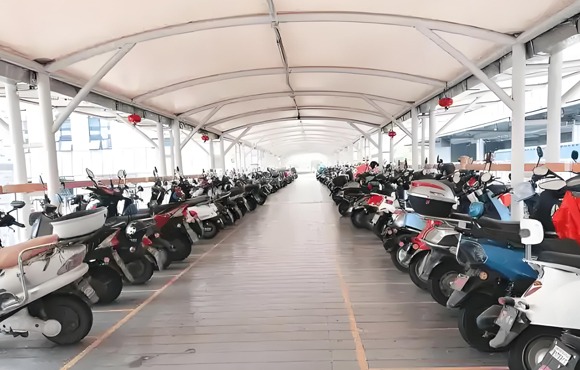Forwarding: Implementation Opinions of the National Development and Reform Commission and the National Energy Administration on Accelerating the Construction of Charging Infrastructure to Better Support New Energy Vehicles Going to Rural Areas and Rural Revitalization
2024-09-24 11:30:031143Hippo
Development and Reform Comprehensive [2023] No. 545
People's Governments of all provinces, autonomous regions, and municipalities directly under the Central Government, Xinjiang Production and Construction Corps, State Grid Corporation of China, and China Southern Power Grid Co., Ltd.:
my country has built the world's largest charging infrastructure system with the largest radiation area and the most comprehensive service vehicles, providing a strong guarantee for the rapid development of new energy vehicles. However, there are still problems in the vast rural areas, such as insufficient construction of public charging infrastructure, difficulty in installing and sharing charging facilities in residential communities, and prominent contradictions between supply and demand during certain periods, which restrict the release of new energy vehicle consumption potential in rural areas. Appropriately building charging infrastructure ahead of time and optimizing the purchase and use environment of new energy vehicles are of great significance to promoting the development of new energy vehicles in rural areas, guiding rural residents to travel green, and promoting the comprehensive revitalization of rural areas. In order to do a good job in related work, with the approval of the State Council, the following implementation opinions are formulated.
1. Innovate the construction, operation and maintenance model of charging infrastructure in rural areas
(I) Strengthen the layout and construction of public charging infrastructure. Support local governments to carry out county and township public charging network planning in light of actual conditions, and do a good job in linking with land space planning and distribution network planning, so as to accelerate the realization of "full coverage of counties" and "full coverage of townships" of charging stations in areas suitable for the use of new energy vehicles. Reasonably promote the construction of centralized public charging stations, give priority to the configuration of public charging facilities in county and township enterprises and institutions, commercial buildings, transportation hubs (stations), service areas (stations) along highways, and extend to resettlement areas for relocation and key villages for rural tourism, and accelerate the construction of charging piles along highways and gas stations with conditions in combination with the development of rural self-driving tourism.
(II) Promote the construction and sharing of community charging infrastructure. Accelerate the construction of charging facilities in existing residential communities in rural areas, carry out the renovation of charging facility construction conditions according to local conditions, and residential communities with installation conditions can be equipped with a certain proportion of public charging parking spaces. Implement the requirements for the construction of charging infrastructure in new residential communities, promote the construction of charging facilities in fixed parking spaces or reserve installation conditions to meet the needs of direct meter installation and power connection. Implement the management responsibilities of grassroots management agencies such as street offices, increase guidance and supervision of residential community management units, and establish a "one-stop" coordination and promotion and complaint resolution mechanism. Residential community management units should actively assist users in installing charging facilities, and explore mechanisms for cooperation with charging facility operators. Guide communities to promote sharing models such as "sharing adjacent parking spaces", "sharing in communities", and "multiple cars on one pile".
(III) Increase support for the construction and operation of charging networks. Encourage qualified places to introduce special support policies for the construction and operation of public charging infrastructure in rural areas. Use tools such as local government special bonds to support the construction of charging and swapping infrastructure such as qualified expressways and ordinary national and provincial trunk road service areas (stations), public bus and tram stations, and bus passenger stations. Take into account the construction of rural charging networks and the development of transmission and distribution networks, increase support such as land guarantees, carry out supporting power grid construction and transformation, and enhance the support and guarantee capabilities of rural power grids. By 2030, the demand (capacity) electricity fee will be waived for the use of electricity by centralized charging and swapping facilities that implement a two-part electricity price, and the efficiency constraints on the investment in distribution network construction of power grid companies will be relaxed, and the full amount will be included in the recovery of transmission and distribution prices.
(IV) Promote new models such as intelligent and orderly charging. Improve the intelligence level of newly built charging infrastructure, include intelligent and orderly charging in the functional scope of charging infrastructure and new energy vehicle products, encourage newly sold new energy vehicles to be equipped with charging piles with orderly charging functions, and accelerate the formation of unified industry standards. Encourage research on key technologies such as two-way interaction between electric vehicles and power grids (V2G) and coordinated control of photovoltaic storage and charging, and explore the construction of charging infrastructure that provides integrated photovoltaic power generation, energy storage, and charging in rural areas with low utilization rates of charging piles. Implement the peak-valley time-of-use electricity price policy to encourage users to charge during off-peak hours.
(V) Improve the operation and maintenance service experience of charging infrastructure. Combined with the charging facility environment, power grid basic conditions, and operation and maintenance requirements in rural areas, carry out the revision and typical design of charging facility construction standards. Improve the charging facility operation and maintenance system, improve the availability of facilities and fault handling capabilities, and promote the interconnection and interoperability of public charging and swapping network operator platforms. Encourage parking lots and charging facility operators to innovate technology and management measures, guide fuel vehicles and new energy vehicles to park in different areas, and maintain a good charging order. Use technical means to conduct early research and judgment on time periods and areas with concentrated charging demand, and provide good service guarantees.
II. Support the purchase and use of new energy vehicles in rural areas
(VI) Enrich the supply of new energy vehicles. Encourage new energy vehicle companies to optimize configuration through differentiated strategies based on the characteristics of rural consumers and develop more economical and practical models, especially new energy cargo minivans, micro trucks, light trucks and other products. Improve the evaluation system for new energy second-hand vehicles, strengthen inspection and renovation of new energy second-hand vehicles, and encourage companies to provide high-quality new energy second-hand vehicles for the rural market.
(VII) Accelerate the application and promotion in the public sector. Accelerate the promotion and application of new energy vehicles in county and township party and government agencies, schools, hospitals and other units, increase the proportion of new energy vehicles used in official vehicles according to local conditions, and play a leading and exemplary role. Encourage places with conditions to increase support for the application of new energy vehicles in public transportation, road passenger transportation, taxis, law enforcement, sanitation, logistics and distribution and other fields.
(VIII) Provide diversified purchase support policies. Encourage places with conditions to provide consumer coupons and other support to rural residents who purchase new energy vehicles in the county where they are registered. Encourage relevant automobile companies and places with conditions to provide old-for-new rewards for the purchase of new energy vehicles by eliminating low-speed electric vehicles. Encourage local governments to strengthen government-enterprise linkage and carry out activities such as giving charging coupons for car purchases. Increase credit support for automobile consumption in rural areas, and encourage financial institutions to reasonably determine the down payment ratio, loan interest rate, and repayment period under the premise of compliance with laws and regulations and controllable risks.
III. Strengthen the publicity and service management of new energy vehicles in rural areas
(IX) Increase publicity and guidance. Actively publicize through news reports, expert comments, Internet new media, etc., support local governments and industry organizations to organize new energy vehicle manufacturers to carry out brand joint exhibitions, test rides and other activities, encourage new energy vehicle companies to cooperate with upstream battery companies in the industrial chain to carry out free "battery physical examinations" within three years of car purchases in rural areas, and enhance consumers' acceptance of new energy vehicles.
(X) Strengthen sales service network. Encourage new energy vehicle companies to sink their sales networks, guide car companies and third-party service companies to accelerate the construction of joint business outlets, establish supporting after-sales service systems, regularly carry out maintenance and after-sales service activities in rural areas, provide emergency rescue and other services, and alleviate concerns about purchase and use. Encourage higher vocational colleges to train new energy vehicle maintenance technicians for rural areas, provide relevant vocational education such as automobile maintenance and charging pile maintenance, which will promote the effective connection between local employment and support for new energy vehicle consumption.
(XI) Strengthen safety supervision. Improve the safety supervision system for new energy vehicles, use a variety of means according to local conditions, improve the quality and safety level of new energy vehicles and batteries, strictly manage charging facilities in rural areas, guide charging facility operators to access the government charging facility supervision platform, strictly provide supporting power supply and centralized charging site safety conditions, ensure compliance with relevant laws and regulations, national standards or industry standards, strengthen safety business training for management personnel, and regularly conduct hidden danger inspections on existing charging piles. Guide rural residents to install and use independent charging piles, and reasonably equip them with leakage protection devices and grounding equipment to improve the safety level of electricity use.
All regions and relevant departments should effectively strengthen organizational leadership, clarify the division of responsibilities, take positive and proactive actions, promote the implementation of relevant policies and measures as soon as possible, improve the purchase and use policies, further improve the charging infrastructure network, ensure "someone to build, someone to manage, and can be sustainable", and create a good environment for the promotion and use of new energy vehicles in rural areas, and better meet the production and living needs of the people.
National Development and Reform Commission
National Energy Administration
May 14, 2023



 Hippo M16S006T lithium battery protection board supports 9-16 series 60A ternary mobile power protection board
Hippo M16S006T lithium battery protection board supports 9-16 series 60A ternary mobile power protection board
 Hippo M17S006 lithium battery protection board 17 series 80A power protection board
Hippo M17S006 lithium battery protection board 17 series 80A power protection board
 Hippo M20S006T lithium battery protection board ternary 13-20 series 100A power protection board supports GPS positioning 4G module
Hippo M20S006T lithium battery protection board ternary 13-20 series 100A power protection board supports GPS positioning 4G module




